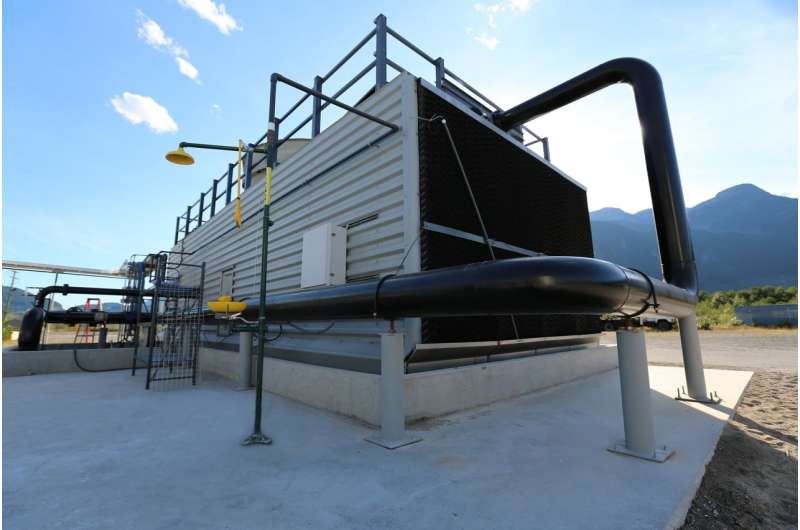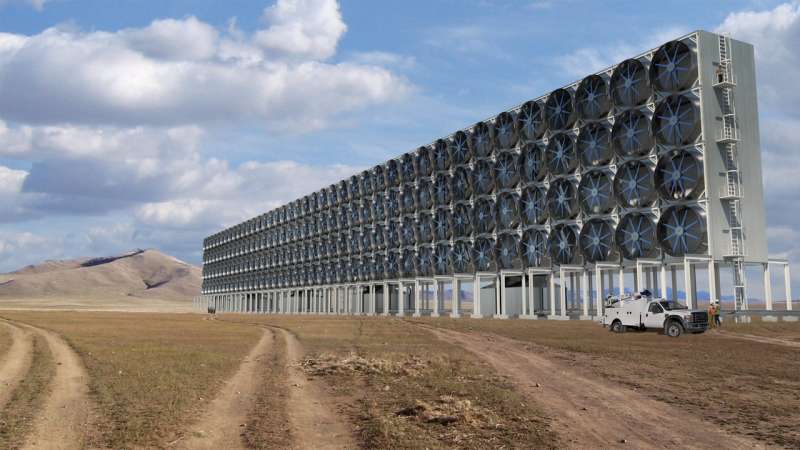How to suck carbon dioxide from the sky for fuels and more

Someday, the gasoline you buy might trace its heritage to carbon dioxide pulled straight out of the sky rather than from oil pumped out of the ground. By removing emitted carbon dioxide from the atmosphere and turning it into fresh fuels, engineers at a Canadian firm have demonstrated a scalable and cost-effective way to make deep cuts in the carbon footprint of transportation with minimal disruption to existing vehicles. Their work appears June 7 in the journal Joule.
"The carbon dioxide generated via direct air capture can be combined with sequestration for carbon removal, or it can enable the production of carbon-neutral hydrocarbons, which is a way to take low-cost carbon-free power sources like solar or wind and channel them into fuels that can be used to decarbonize the transportation sector," says lead author David Keith, founder and chief scientist of Carbon Engineering, a Canadian CO2-capture and clean fuels enterprise, and a professor of applied physics and public policy at Harvard University.
Direct air capture technology works almost exactly like it sounds. Giant fans draw ambient air into contact with an aqueous solution that picks out and traps carbon dioxide. Through heating and a handful of familiar chemical reactions, that same carbon dioxide is re-extracted and ready for further use—as a carbon source for making valuable chemicals like fuels, or for storage via a sequestration strategy of choice. It's not just theory—Carbon Engineering's facility in British Columbia is already achieving both CO2 capture and fuel generation.

The idea of direct air capture is hardly new, but the successful implementation of a scalable and cost-effective working pilot plant is. After conducting a full process analysis and crunching the numbers, Keith and his colleagues claim that realizing direct air capture on an impactful scale will cost roughly $94-$232 per ton of carbon dioxide captured, which is on the low end of estimates that have ranged up to $1,000 per ton in theoretical analyses.
That price-point is low enough to use direct air capture to start tackling the roughly 20% of global carbon emissions that result from driving, flying, trucking, and other ways of getting people and goods around. "Electricity from solar and wind is intermittent; we can take this energy straight from big solar or wind installations at great sites where it's cheap and apply it to reclaim and recycle carbon dioxide into new fuel," Keith says, adding that "Making fuels that are easy to store and transport eases the challenge of integrating renewables into the energy system."
The resulting fuels, including gasoline, diesel, and jet fuel, are compatible with existing fuel distribution and transportation infrastructure. Thanks to ultra-low life cycle carbon intensities, they are a promising route for reducing carbon emissions in heavy transportation and other sectors of the energy system that are demanding and difficult to electrify.

Centuries of unchecked human carbon emissions also mean that atmospheric carbon dioxide is a virtually unlimited feedstock for transformation into new fuels. "We are not going to run out of air anytime soon," adds Steve Oldham, CEO of Carbon Engineering. "We can keep collecting carbon dioxide with direct air capture, keep adding hydrogen generation and fuel synthesis, and keep reducing emissions through this AIR TO FUELSTM pathway."
Keith and Oldham are optimistic that they have reduced scale-up risks by implementing direct air capture at reasonable costs using standard industrial equipment. That means that all the pieces are in place to move on to full-size plants capable of manufacturing 2,000 barrels of fuels per day— totaling over 30 million gallons per year across plants. Commercialization of such plants would allow direct air capture to make a dent in transportation emissions by connecting low-cost renewable energy to low-carbon transportation fuels using Carbon Engineering's AIR TO FUELSTM pathway.
"After 100 person-years of practical engineering and cost analysis, we can confidently say that while air capture is not some magical cheap solution, it is a viable and buildable technology for producing carbon-neutral fuels in the immediate future and for removing carbon in the long run," says Keith.
More information: Joule, Keith et al.: "A process for capturing CO2 from the atmosphere", DOI: 10.1016/j.joule.2018.05.006
Journal information: Joule
Provided by Cell Press




















